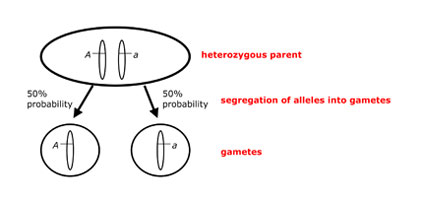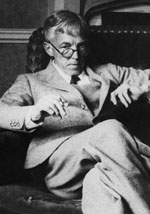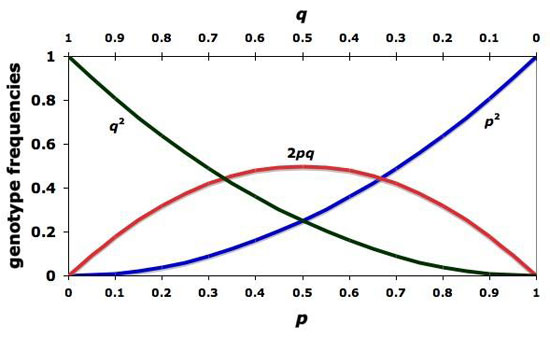« Prev Next »
Basic Mendelian Genetics
Under the now-discredited theory of blending inheritance, the hereditary material was conceived as a fluid that combines the traits from two individuals into phenotypically intermediate offspring. Given observed patterns of resemblance between parents and offspring, blending inheritance may seem intuitively reasonable, as it did to many of Charles Darwin’s contemporaries. This mode of inheritance, however, posed problems for Darwin’s theory of natural selection (1859), which depends on the existence of heritable trait variation in populations of organisms. Blending inheritance would quickly erode such variation, since all traits would be combined from one generation to the next until all individuals shared the same blended phenotype. In his famous experiments on pea plants, Gregor Mendel rejected this hereditary mechanism in favor of particulate inheritance by demonstrating that alternative versions of genes (alleles) account for variations in inherited characters, though he didn’t actually know about genes as such. Although Mendel published his results in 1866, his work remained obscure until its rediscovery in 1900 (reviewed in Monaghan & Corcos 1984), which helped give rise to the modern field of genetics.
Mendel’s Law of Segregation, in modern terms, states that a diploid individual carries two individual copies of each autosomal gene (i.e., one copy on each member of a pair of homologous chromosomes). Each gamete produced by a diploid individual receives only one copy of each gene, which is chosen at random from the two copies found in that individual. Under Mendel’s Law of Segregation, each of the two copies in an individual has an equal chance of being included in a gamete, such that we expect 50% of an individual’s gametes to contain one copy, and 50% to contain the other copy (Figure 1).


Even after many geneticists had accepted Mendel’s laws, confusion lingered regarding the maintenance of genetic variation in natural populations. Some opponents of the Mendelian view contended that dominant traits should increase and recessive traits should decrease in frequency, which is not what is observed in real populations. Hardy (1908; Figure 2) refuted such arguments in a paper that, along with an independently published paper by Weinberg (1908; Figure 3) laid the foundation for the field of population genetics (Crow 1999; Edwards 2008).
The Hardy-Weinberg Equilibrium

- allele frequencies in a population will not change from generation to generation.
- if the allele frequencies in a population with two alleles at a locus are p and q, then the expected genotype frequencies are p2, 2pq, and q2. This frequency distribution will not change from generation to generation once a population is in Hardy-Weinberg equilibrium. For example, if the frequency of allele A in the population is p and the frequency of allele a in the population is q, then the frequency of genotype AA = p2, the frequency of genotype Aa = 2pq, and the frequency of genotype aa = q2. If there are only two alleles at a locus, then p + q , by mathematical necessity, equals one. The Hardy-Weinberg genotype frequencies, p2 + 2pq + q2, represent the binomial expansion of (p + q)2, and also sum to one (as must the frequencies of all genotypes in any population, whether it is in Hardy-Weinberg equilibrium). It is possible to apply the Hardy-Weinberg Theorem to loci with more than two alleles, in which case the expected genotype frequencies are given by the multinomial expansion for all k alleles segregating in the population: (p1 + p2 + p3 + . . . + pk)2.
- Natural selection is not acting on the locus in question (i.e., there are no consistent differences in probabilities of survival or reproduction among genotypes).
- Neither mutation (the origin of new alleles) nor migration (the movement of individuals and their genes into or out of the population) is introducing new alleles into the population.
- Population size is infinite, which means that genetic drift is not causing random changes in allele frequencies due to sampling error from one generation to the next. Of course, all natural populations are finite and thus subject to drift, but we expect the effects of drift to be more pronounced in small than in large populations.
- Individuals in the population mate randomly with respect to the locus in question. Although nonrandom mating does not change allele frequencies from one generation to the next if the other assumptions hold, it can generate deviations from expected genotype frequencies, and it can set the stage for natural selection to cause evolutionary change.
If the genotype frequencies in a population deviate from Hardy-Weinberg expectations, it takes only one generation of random mating to bring them into the equilibrium proportions, provided that the above assumptions hold, that allele frequencies are equal in males and females (or else that individuals are hermaphrodites), and that the locus is autosomal. If allele frequencies differ between the sexes, it takes two generations of random mating to attain Hardy-Weinberg equilibrium. Sex-linked loci require multiple generations to attain equilibrium because one sex has two copies of the gene and the other sex has only one.
Given these conditions, it is easy to derive the expected Hardy-Weinberg genotype frequencies if we think about random mating in terms of the probability of producing each genotype via random union of gametes into zygotes (Table 1). If each allele occurs at the same frequencies in sperm and eggs, and gametes unite at random to produce zygotes, then the probability that any two alleles will combine to form a particular genotype equals the product of the allele frequencies. Since there are two ways of generating the heterozygous genotype (A egg and a sperm, or a egg and A sperm), we sum the probabilities of those two types of union to arrive at the expected Hardy-Weinberg frequency of the heterozygous genotype (2pq).

It is important to recognize that the Hardy-Weinberg equilibrium is a neutral equilibrium, which means that a population perturbed from its Hardy-Weinberg genotype frequencies will indeed reach equilibrium after a single generation of random mating (if it conforms to the other assumptions of the theorem), but it will be a new equilibrium if allele frequencies have changed. This property distinguishes a neutral equilibrium from a stable equilibrium, in which a perturbed system returns to the same equilibrium state. It makes sense that the Hardy-Weinberg equilibrium is not stable, since a change from the equilibrium genotype frequencies will generally be associated with a change in allele frequencies (p and q), which will in turn lead to new values of p2, 2pq and q2. Thereafter, a population that meets Hardy-Weinberg assumptions will remain at the new equilibrium until perturbed again.
Given a population in which we know the number of individuals with each genotype, we can test for statistical deviation from Hardy-Weinberg equilibrium using a simple chi-square goodness-of-fit test or a more powerful exact test. The latter class of methods has proved particularly useful for large-scale genomic studies, in which scientists evaluate thousands of loci segregating for multiple alleles (Wiggington et al. 2005). Observed genotype proportions in natural populations typically conform to Hardy-Weinberg expectations, as we might expect given that a population perturbed from equilibrium can achieve new equilibrium frequencies after only one generation of random mating.
Although statistical deviation from Hardy-Weinberg expectations generally indicates violation of the assumptions of the theorem, the converse is not necessarily true. Some forms of natural selection (e.g., balancing selection, which maintains multiple alleles in a population) can generate genotypic frequency distributions that conform to Hardy-Weinberg expectations. It may also be true that migration or mutation is occurring, but at such low rates as to be undetectable using available statistical methods. And, of course, all real populations are finite and thus susceptible to at least some evolution via genetic drift.
Evolutionary Implications of the Hardy-Weinberg Theorem
The Hardy-Weinberg Theorem demonstrates that Mendelian loci segregating for multiple alleles in diploid populations will retain predictable levels of genetic variation in the absence of forces that change allele frequencies. A common way of visualizing these expectations is to plot p2, 2pq and q2 as a function of allele frequencies (Figure 4). This graphical presentation emphasizes two important consequences of the Hardy-Weinberg principle:
- Population heterozygosity (the frequency of heterozygotes) is highest when p = q = 0.5.
- Rare alleles are found primarily in heterozygotes, as they must be, given that q2 is much smaller than 2pq when q is near zero, and p2 is much smaller than 2pq when p is near zero.

Selection, mutation, migration, and genetic drift are the mechanisms that effect changes in allele frequencies, and when one or more of these forces are acting, the population violates Hardy-Weinberg assumptions, and evolution occurs. The Hardy-Weinberg Theorem thus constitutes a null model for the discipline of population genetics, and is fundamental to the study of evolution.
References and Recommended Reading
Crow, J. F. Eighty years ago: the beginnings of population genetics. Genetics 119, 473-476 (1988).
Crow, J. F. Hardy, Weinberg and language impediments. Genetics 152, 821-825 (1999).
Darwin, C. On the Origin of Species by Means of Natural
Selection, or the Preservation of Favoured Races in the Struggle for Life.
London, UK: John Murray, 1859. (link)
Edwards, A. W. F. & Hardy, G. H. 1908 and Hardy-Weinberg Equilibrium. Genetics 179, 1143-1150 (2008).
Futuyma, D. J. Evolutionary Biology, 3rd ed. Sunderland, MA: Sinauer & Associates, 1998.
Gillespie, J. H. Population Genetics: A Concise Guide, 2nd ed. Baltimore, MD: Johns Hopkins University Press, 2004.
Hardy, G. H. Mendelian proportions in a mixed population. Science 28, 49-50 (1908).
Mendel, G. Versuche über Plflanzen-hybriden. Verhandlungen des naturforschenden Ver-eines in Brünn, Bd. IV für das Jahr 1865, Abhand-lungen (1886): 3-47. (link)
Monaghan, F. & Corcos, A. On the origins of the Mendelian laws. Journal of Heredity 75, 67-69 (1984).
Weinberg, W. Über den Nachweis der Vererbung beim Menschen. Jahreshefte des Vereins Varterländische Naturkdunde in Württemberg 64, 369-382 (1908).
Wigginton, J. E., Cutler, D. J. et al. A note on exact tests of Hardy-Weinberg equilibrium. The American Journal of Human Genetics 76, 887-893 (2005).































